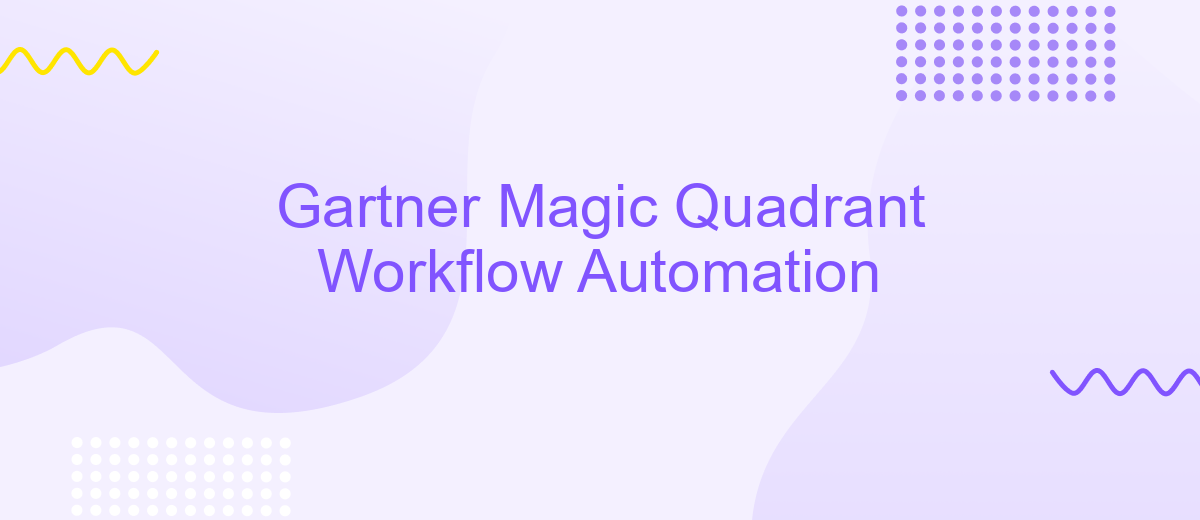Gartner Magic Quadrant Workflow Automation
The Gartner Magic Quadrant for Workflow Automation provides a comprehensive analysis of the leading vendors in the workflow automation industry. This report evaluates each vendor's ability to execute and completeness of vision, offering valuable insights for organizations seeking to enhance their operational efficiency. Discover the top performers and emerging players shaping the future of workflow automation in this detailed assessment.
Overview
The Gartner Magic Quadrant for Workflow Automation provides a comprehensive analysis of the leading vendors in the workflow automation market. This report evaluates vendors based on their ability to execute and completeness of vision, offering valuable insights for organizations looking to streamline their operations through automation.
- Identifies key players in the workflow automation space
- Assesses vendors on criteria such as innovation, customer experience, and market presence
- Helps organizations make informed decisions when selecting workflow automation solutions
One notable tool in this space is ApiX-Drive, which simplifies the integration of various applications and services. By using ApiX-Drive, businesses can automate workflows without the need for extensive coding, enhancing efficiency and reducing manual errors. The Gartner Magic Quadrant serves as a crucial resource for evaluating such tools and understanding their impact on modern business processes.
Market Trends

In recent years, the workflow automation market has experienced significant growth, driven by the increasing need for businesses to streamline operations and enhance productivity. Companies are investing in advanced automation tools to reduce manual tasks, improve accuracy, and accelerate decision-making processes. The rise of artificial intelligence (AI) and machine learning (ML) technologies has further fueled this trend, enabling more sophisticated and intelligent automation solutions. As a result, organizations are now able to achieve higher levels of efficiency and operational excellence.
One notable trend in the market is the growing importance of integration capabilities. Businesses are seeking platforms that can seamlessly connect with various applications and services to create a cohesive and automated workflow ecosystem. Services like ApiX-Drive have become essential in this context, offering robust integration solutions that allow companies to easily link their existing systems and automate data transfers. This not only simplifies the implementation of automation initiatives but also ensures that disparate systems work harmoniously together, thereby maximizing the benefits of workflow automation.
Vendor Analysis

In the ever-evolving landscape of workflow automation, several vendors have distinguished themselves by offering unique features and capabilities. These vendors provide solutions that cater to various business needs, from simple task automation to complex enterprise-level workflows.
- UiPath: Known for its robust robotic process automation (RPA) capabilities, UiPath excels in automating repetitive tasks, significantly reducing manual effort.
- Automation Anywhere: This platform offers a comprehensive suite of tools for end-to-end automation, including advanced analytics and cognitive automation features.
- ApiX-Drive: Specializing in seamless integrations, ApiX-Drive simplifies the process of connecting various software applications, making it easier for businesses to streamline their workflows.
- Blue Prism: Blue Prism focuses on secure and scalable automation solutions, ideal for large enterprises with complex compliance requirements.
- Microsoft Power Automate: Integrated with the Microsoft ecosystem, Power Automate offers a user-friendly interface and extensive pre-built connectors for rapid deployment.
Each vendor brings unique strengths to the table, making it essential for organizations to carefully evaluate their specific needs and objectives. Whether it's the advanced RPA features of UiPath or the integration capabilities of ApiX-Drive, the right choice can significantly enhance operational efficiency and drive business growth.
Key Criteria for Evaluation

When evaluating workflow automation solutions, it is crucial to consider several key criteria to ensure the tool meets your organization's needs. These criteria help in assessing the efficiency, flexibility, and overall value of the automation platform.
Firstly, examine the ease of use and user interface. A solution with an intuitive design can significantly reduce the learning curve and improve adoption rates among employees. Secondly, consider the scalability of the platform. It should be capable of growing with your business and handling increased workloads without compromising performance.
- Integration Capabilities: The tool should seamlessly integrate with existing systems and third-party applications. Services like ApiX-Drive can simplify this process by providing robust integration options.
- Customization: Look for a platform that allows extensive customization to tailor workflows to specific business processes.
- Support and Training: Ensure the vendor offers comprehensive support and training resources to help your team maximize the tool's potential.
- Security: The platform must have strong security measures to protect sensitive data and comply with industry regulations.
By focusing on these key criteria, organizations can select a workflow automation solution that not only meets their current requirements but also supports future growth and innovation.
Recommendations
To maximize the benefits of workflow automation as outlined in the Gartner Magic Quadrant, organizations should begin by thoroughly assessing their current processes to identify areas that would most benefit from automation. Prioritize workflows that are repetitive, time-consuming, and prone to human error. Implementing automation in these areas will yield the most significant efficiency gains and cost savings. Additionally, ensure that your team is adequately trained to use and manage the new automation tools effectively.
For seamless integration of various applications and systems, consider utilizing services like ApiX-Drive. This platform simplifies the process of connecting different software and automating data transfers between them, ensuring a smooth and efficient workflow. By leveraging ApiX-Drive, organizations can eliminate manual data entry, reduce errors, and enhance overall productivity. Regularly review and update your automation strategies to adapt to evolving business needs and technological advancements, ensuring sustained success in your workflow automation initiatives.


FAQ
What is the Gartner Magic Quadrant for Workflow Automation?
How can businesses benefit from using workflow automation tools?
What factors should be considered when choosing a workflow automation tool?
How do I integrate workflow automation tools with existing systems?
What are some common use cases for workflow automation?
Time is the most valuable resource in today's business realities. By eliminating the routine from work processes, you will get more opportunities to implement the most daring plans and ideas. Choose – you can continue to waste time, money and nerves on inefficient solutions, or you can use ApiX-Drive, automating work processes and achieving results with minimal investment of money, effort and human resources.

